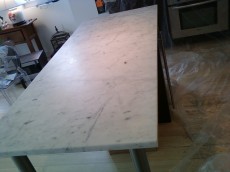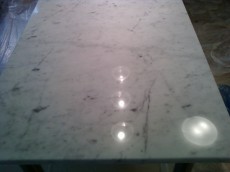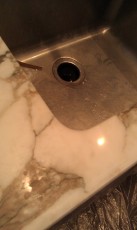Process of Marble Countertop Refinishing
Marble refinishing is usually referring to process of modifying marble surface. The purpose of countertop refinishing can be a surface restoration, changing its appearance or both.
In case of restoration, a surface won’t change its initial finish. So if counter has shine finish and scratches, dull spots or whatever damages on its surface, all damages will be removed along with top layer of marble, and then restored to initial shine finish.
In case of changing appearance or changing finish, the top layer of marble will be modified to desirable result. It can be changed form shine/gloss to honed/matt finish or backward. There are a several possible finishes such as deep hone, medium hone, high hone, semi shine and shine.
Countertop Restoration
To perform a countertop restoration we are using a variable speed polisher, set of resin bonded diamond pads with progressive diamond grits.
The complete standard set contains various pads starting from 30 grits (most rough and aggressive) and ending with 5000 grits (finest grits). The diameter may vary from 3 to 7 inches. Depending of a material a different pad combination can be used.
For a marble countertop repair we use following pad combination 400 -> 600 -> 800 ->1000 grits and then buffing. If surface has deep scratches or stains we are starting with lower diamond grits, it can be 50-100-200 grits.
Buffing is another process in restoration and differs from diamond polishing. Buffing is utilizing chemical and mechanical actions on surface and intended to produce a glossy finish.
For buffing we use a buffing compound, it’s a balanced conglomeration of acidic chemicals and abrasive particles. Buffing is final step to produce desirable gloss.
Changing a Surface Finish
Changing finish or changing surface appearance is simpler process if it’s a new countertop or there are not damages to restore.
For turning shine into hone/matt finish can be used just one diamond pad with lower grid or honing powder. To hone can be used pad with 400 – 600 – 800 – 1000 grits.
For turning hone into shine finish a standard polishing process should be used.
Performing and Completing
One of important condition for proper marble refinishing is evenly, thorough-passing polishing for each diamond grid. To make sure there are not missed spots or deep scratches, after each step we are closely inspecting each part, only then we go to a next step.
Some part that cannot be reached by polisher such as corners, faucets, soap dispensers etc. we polish it manually as much as we can reach the space.
Edges refinishing usually is not included in the work by default, unless it specified by client. Typically edges are not required refinishing. More often a chipping may occur as it’s exposed to hitting heavy objects such as kitchenware or appliances.
If there are other damages, we are planning a work progression. Usually first we do chips, cracks repair and at the end we do caulking and sealing.
A sealing full cure time is 4-24 hours, so a counter should not be used during that time.
| Before Refinishing | After Refinishing |
 |
 |
| Dull Countertop | Restored Countertop |
 |
 |
| Etched Spots | Polished Top |
 |
 |
Submit Your Order or Ask a Question :
You'll get a response within a few minutes or hours and usually not longer than 24 hours.

